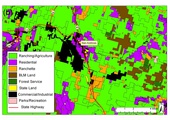Highlight
Invasive species in a management mosaic
Achievement/Results
NSF-funded researchers at the University of California, Davis, have found that increasing the number of land managers and decreasing the size of land holdings in a region can negatively impact the control of invasive species. Increased division into more complex “management mosaics” reduces incentives to control in two ways: first, by dividing invasion damages among more managers (thus reducing the damages experienced by each individual manager); and second, by increasing the likelihood of continued reinfestation from lands whose managers choose not to control. The resulting reduction in regional control of invasive species raises the potential of those species to cause economic and ecological harm.
UC Davis graduate students Rebecca Epanchin-Niell, Clare Aslan, Matthew Hufford, Jeff Port, Jason Sexton, and Tim Waring used interviews and surveys of cattle ranchers to examine how land divisions and multiple land managers affect control of invasive species. They focused on yellow starthistle as a case study invasive species, but applied their conclusions more broadly to biological invasions in general through theoretical examination of the damages and control costs imposed by invasive species under varying scenarios of land ownership.
Sampled ranchers declared that the presence of yellow starthistle on their property reduces available forage for livestock and therefore represents tangible economic hardship. However, they provided evidence that their inclination to invest in control diminishes if adjacent land contains uncontrolled infestations. Three-quarters of interviewees reported that infestations on neighboring lands affect them and a quarter stated that the threat if re-invasion from these lands has reduced their investment in control on their own lands.
Greater degrees of subdivision thus complicate control efforts, but additional difficulties arise from enhanced diversity of management types in the region. Land under differing management goals inherently carry differing weed control incentives. Sampled ranchers declared that former ranchlands that have now been converted to roadsides, residential properties, or so-called “hobby ranches” experience very little weed control because the presence of yellow starthistle does not represent an economic threat to those lands. Demographic changes in ranching areas in California have been well-documented over recent decades: ranching has become less profitable and exurban migration to the region has spiked. Rangeland conversion therefore is on the rise, and inserts into the management mosaic parcels with lowered or no control incentive.
To address these difficulties, the researchers found that formal cooperation among neighboring managers can improve success of regional invasive species management. If adjacent land managers coordinate their control efforts to minimize spread of weeds across fencelines, the threat of re-infestation following control efforts diminishes and incentives to control increase. Indeed, 68% of interviewed ranchers called for coordinated control efforts in the region. One interviewed rancher stated: “I do not think that we can eradicate it because it’s all along the highways. Until the state [controls along roadways], it’s going to come into my field. If we declare war, we gotta be united.” Coordination among neighbors and between parcels under differing land use is therefore essential for the effects of complex management mosaics to be mitigated.
Support from the US National Science Foundation Integrative Graduate Education and Traineeship program and US Department of Agriculture’s Environmental Research Service made this research possible.
Address Goals
Throughout rural regions in the US, rangelands have become mosaics of privately owned agricultural lands, residential holdings, federally managed lands, and state and local parcels. These mosaics are further subdivided and grow more diverse as rural populations increase, family-run ranching becomes less profitable, and land prices rise. Invasive species control in these mosaics is complicated by the diversity of incentives and division of damages, and must be addressed through active coordination of control efforts. Through interviews and surveys, this research allowed comparison of theoretical predictions with common practice and local experiences. The researchers analyzed results and developed suggestions that provide local, state, and federal land managers with strategies for developing coordinated control efforts across management mosaics.
Further, the research is being published in a journal accessible to policymakers, and will be revised in a non-technical white paper that will be disseminated to extension agents and weed control specialists in the region.







